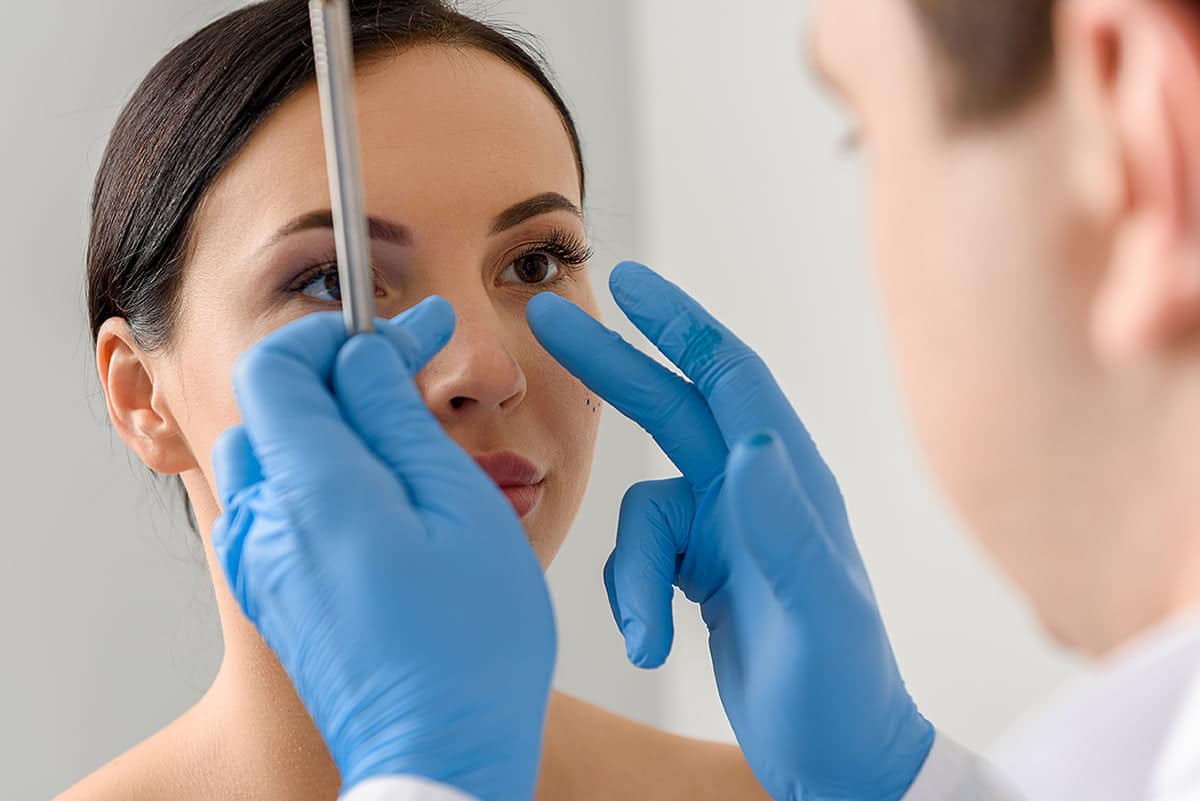
The non-surgical rhinoplasty is also known as a “non-surgical nose job”, “liquid rhinoplasty” or more colloquially as “nose filler”. The reason why the non-surgical rhinoplasty procedure can be referred to as nose filler is the product that is used in this treatment is typically a hyaluronic acid-based derma filler.
There are many benefits to this procedure, the non-surgical rhinoplasty can provide a range of results depending on how and where the filler is used. Non-surgical nose filler can be used to soften the appearance of a nasal hook, provide a nose with symmetry, disguise flat nose bridges, as well as bumps, along with providing an overall refining of your nasal shape.
Other benefits of the procedure include not requiring costly surgery, plus the results are instant, what’s not to love? Given that rhinoplasty is one of the most requested facial surgeries, there is little wonder that this procedure is fast growing in popularity worldwide.
While the results of the non-surgical rhinoplasty procedure are instantaneous, they are not permanent. Most non-surgical nose treatment results last up to 12-18 months however, many people will require up to four treatments to achieve the desired result. These repeat treatments are usually undertaken with a minimum of one month in between.
While non-surgical procedures are often assumed to be safer and less invasive than undergoing surgery, the procedure is not entirely without risk. Any associated risks of this procedure are drastically minimised if you are in the hands of a highly qualified practitioner, preferably a plastic surgeon or doctor who has an intimate knowledge of facial anatomy.
Good Candidates for the Non-surgical Rhinoplasty Procedure
Preparation
There are certain conditions that may negatively impact the use of dermal fillers. You will need to advise your practitioner about any medications that you are using to prevent any cross-reactions. You will also need to discuss this treatment in advance with your practitioner if you are:
Just as important as the procedure is the conversation you will have with your skilled practitioner (preferably a plastic surgeon, or a qualified doctor) prior to treatment. A detailed conversation will ensure that you are both clear about the expectations and the reality of what can be achieved.
Once you are both satisfied with how the procedure will proceed, will numb the nose with an anaesthetic cream prior to your treatment. A local anaesthetic is in the dermal filler that vastly reduces any discomfort. Ice is also used to minimise any discomfort, as well as to reduce any bruising and swelling.
The skilled doctor will then place the dermal filler in precisely the areas of the nose as discussed with you, prior to treatment. There should be minimal discomfort and the procedure can usually take less than an hour, but more commonly it is usually closer to half an hour.
Your results are instant, though there they will continue to improve after the treatment once all the swelling has gone down. You can continue to use ice on the nose after your treatment once to reduce the swelling as quickly as possible.
Bruising occurs in a significant number of non-surgical Rhinoplasty Procedure cases, though for a vast majority of people this will only last for up to 48 hours. It may take longer for some people for all the swelling to subside, especially if there were several areas of the nose that were injected, though even in these cases, the swelling will inevitably subside by week four.
Asymmetry can occur, though it typically occurs if the nose was asymmetrical to start with. This can usually be addressed with follow up treatments.
Redness. Prolonged redness due to facial capillaries being damaged during the procedure is another rare complication, which may be permanent, though it usually resolves over time as the filler dissolves.
Infection. Any time you are injected, there is a very small, but real possibility of infection. is a very rare complication, but always a possibility when the needle goes into the skin.
Necrosis. This is another very rare risk, however, the nose is more susceptible to necrosis, a condition caused by a blocked blood vessel. necrosis can also lead to scarring.
Blindness. This is another very rare, serious complication.
As described above, any associated risks of this procedure are minimised if you are treated by a highly qualified practitioner such as a plastic surgeon who has an intimate knowledge of facial anatomy. Of all the non-surgical treatments available, this is one of the more transformative, but it is a procedure that is best when it is in the hands of a qualified surgeon or doctor.
Q. Is the non-surgical rhinoplasty procedure painful?
A. Everyone is different, but with numbing cream and a built-in local anaesthetic in most filler products, plus ice to minimise swelling, the procedure is typically described as uncomfortable, but not necessarily painful.
Q. Is there anything I should do, or avoid after treatment?
A. Yes. Avoid makeup, acid facial products and intense exercise for at least 24 hours. Avoid spas, saunas and hot yoga for at least a week post-treatment.
Q. How long do the results of a non-surgical rhinoplasty last?
A. Depending on your age and overall health, the results of your non-surgical rhinoplasty procedure should last between 12-18 months.
Q. What if I am not happy with the result?
A. You will not be able to definitively judge the result of your non-surgical rhinoplasty procedure until at least one month after treatment. For some people, that four weeks can feel like a long time! If you are still not happy after one month, contact the practitioner for a review and for guidance on how to achieve the results you are looking for. depending on the product used, in some cases, the product can be dissolved. This would be something that you may want to discuss, prior to your treatment.